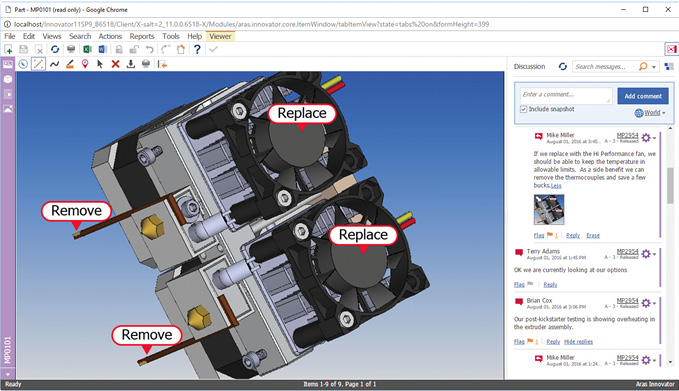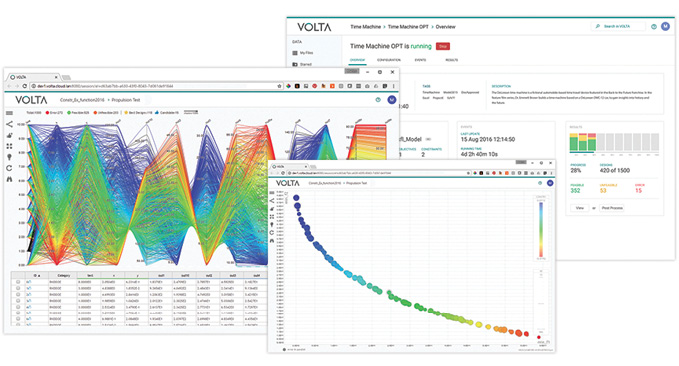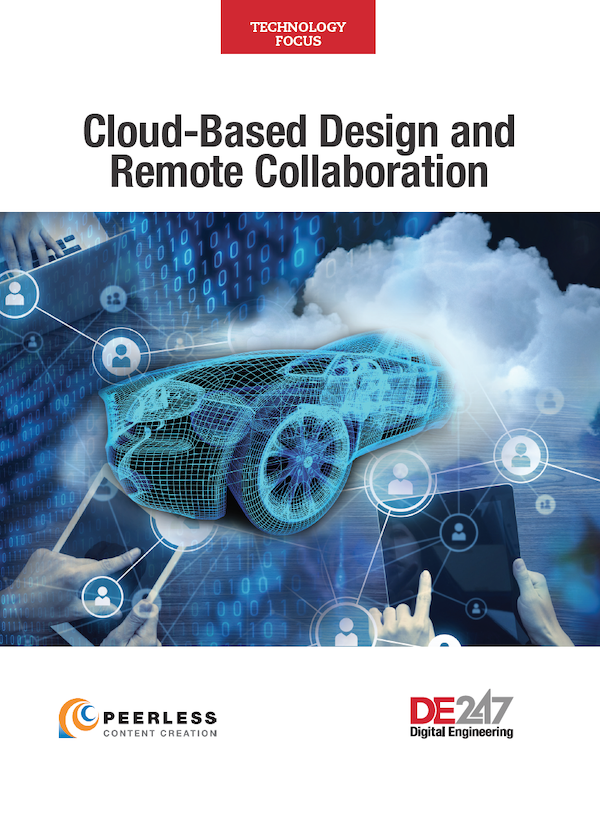Put Engineering Collaboration Front and Center

Autodesk Fusion 360 is a cloud-enabled collaborative product development platform that offers CAD, CAM and simulation features in a concurrent access environment. Image courtesy of Autodesk.
Latest News
March 1, 2017
From the early days of computer-aided design until today, Airbus has been intentional about pushing the possibilities of engineering technology. First there were electronic drawings; later digital mockups. In 1999 Airbus moved to concurrent engineering, creating methods, processes and tools to serve all functional design disciplines. Today Airbus is implementing collaborative engineering, which it defines as “the integration of functional and industrial design teams to produce a single deliverable, an industrial digital mockup (iDMU).”
Researchers at Madrid Polytechnic University recently studied the Airbus approach to collaborative engineering. They found management chose to break down “the wall between functional design and industrial design and to perform the design process with a unique team.” The researchers found five elements that defined each transitional stage as Airbus moved from traditional to concurrent to collaborative methods.
Airbus is large enough to take a leadership role in creating a collaborative engineering environment; most companies depend on their software vendors to provide the new tools required to advance from traditional and concurrent engineering. Thanks to consumer-class social media and the use of concurrent engineering practices in software development, the pressure is on product design and manufacturing companies to adopt collaborative engineering procedures.
There is strong temptation to add social media tools and methods to existing engineering software and workflow. But there are significant drawbacks to borrowing consumer or enterprise software for engineering. Dropbox may make it easier to send a 3D model, but what happens to document control? Is it OK to use Skype or Facebook Messenger as a communications channel in product design? When it comes to collaborative engineering, there is a bit of the proverbial blind men describing an elephant feeling, but advances are being made around the themes of improving workflows, improving access to data and protecting engineering from time-wasting practices or technologies.

The PLM Underground
Significant conversations take place in product design, but do they always take place within the frame of product lifecycle management (PLM)? For most companies the answer is “no.” Even with a PLM system in place, most of the dialog takes place in email. Such practices are part of what Aras Software calls The PLM Underground. “Do you have any Excel spreadsheets with 40 tabs and hundreds of macros? That’s your PLM system,” claims Peter Schroer, Aras CEO. “Look at the network bandwidth between your site and Dropbox. The PLM Underground is sending your corporate IP (intellectual protocol) via email, FTP and Dropbox to suppliers.”
 Aras Innovator PLM software includes Visual Collaboration, a browser-based environment for model and document review. Image courtesy of Aras Software.
Aras Innovator PLM software includes Visual Collaboration, a browser-based environment for model and document review. Image courtesy of Aras Software.Aras, which develops the Aras Innovator PLM system, identifies three problem areas for engineering collaboration, according to product marketing director Doug McDonald.
1. Security: Email and other forms of direct communications are “potentially insecure ... it is important to keep these communications secure, even within the organization.”
2. Context: If an engineer has a question about materials, she might call up a model, but is it the right model? “Context is important in collaboration; engineers must be able to get answers from the right place at the right time.” Too often such searches become “micro-level interactions using email or Dropbox,” McDonald says, further weakening the security as well as potentially leading the engineer in the wrong direction.
3. Verification: There is no consistent, automated way to store, access and verify communications outside the PLM system. This makes it impossible to establish an audit trail, crucial in some industries.
Electronic vs. Digital Collaboration
Data in collaborative environments needs to be granular; accessible at its most fundamental level. At the same time, not everyone in the value chain needs the same level of data granularity.
Dassault Systèmes’ Ramesh Haldora, VP of Strategic Consulting for the 3DEXPERIENCE platform, says granularity of data is an important reason to move from electronic engineering documents to a single digital platform. “Consider the boarding pass,” he says. “Ten years ago we had paper documents, five years ago we would check in online and download a PDF. Today we have a digital boarding pass; if there is a gate change the boarding pass updates.” With each improvement the granularity changed and utility increased. The PDF was an electronic document, the boarding pass in the app is a digital display connected to the flight database. The passenger may only need to read gate and departure information, but the bar code with the digital boarding pass tells the airline gate agent everything she needs to know to allow the passenger on board. Each person in the value chain can access the data they need at the level of detail required, and it the data is always current.
Haldora says the digital platform Dassault has built based on its core applications—CATIA for modeling, SIMULIA for simulation, and ENOVIA for data management—provides the single data model approach, moving on from electronic sharing to digital access. “We have been on the digital platform for almost nine years; the technology is robust. CATIA engineers can now work directly with simulation engineers. They work at the same time on the same version of the truth,” he says. He calls the ability to do 256 iterations on four parameters—instead of one at a time as in the serial workflow of traditional engineering—“a quantum difference” in the engineering workflow.
 Autodesk Fusion 360 is a cloud-enabled collaborative product development platform that offers CAD, CAM and simulation features in a concurrent access environment. Image courtesy of Autodesk.
Autodesk Fusion 360 is a cloud-enabled collaborative product development platform that offers CAD, CAM and simulation features in a concurrent access environment. Image courtesy of Autodesk.Granularity is vital, but the need for it “varies massively,” says Leo Kilfoy, general manager of MSC’s Engineering Lifecycle Management Business Unit. “Often, drawings or models are the key focus. But at other stages it might be a reserve factor or a margin of safety that is the focus.”
What matters is the pedigree of the data, adds Keith Dunlop, a senior technical consultant with MSC, “[to] ensure there is a clear audit that connects these data islands during the development phases and often well after the product is in service.”
But if all information is accessible, are engineers inundated with too much data? “The key to managing information overload is to create semantics and meaning, giving context to the data for engineering change,” says Dassault Systèmes’ Haldora. If you don’t do that, users will create their own meaning from data.
Synchronous or Asynchronous?
Not every engineering software company is working to provide real-time collaboration as the norm. “We make a distinction between synchronous and asynchronous collaboration,” says Dan Staples, VP of Product Development for the mainstream engineering division of Siemens PLM Software. “Most people prefer asynchronous work; it is working on their own timeline: ‘Tell me what you think of the model; mark it up and send it back.’” The synchronous model is “nice but can be overused,” says Staples. “It is the yappy dog. Fundamentally, engineers need asynchronous collaboration at the bottom of the pyramid and synchronous at the top. It’s not as important.”
ESTECO approaches its role in engineering as providing for a team approach. “No single expert can do the entire simulation; this pushes engineers to work together,” says Matteo Nicolich, the ESTECO engineering solutions product manager. “We use collaboration to give simulation experts a way to build processes and connect with PLM apps, and to give visibility to managers and others in the process, to deliver their expertise.”
 ESTECO Volta is a new web-based simulation collaboration application, designed to encourage collaborative engineering and knowledge management for the dispersed enterprise. Image courtesy of ESTECO.
ESTECO Volta is a new web-based simulation collaboration application, designed to encourage collaborative engineering and knowledge management for the dispersed enterprise. Image courtesy of ESTECO.ESTECO sees democratization of engineering data as a crucial piece of creating a collaborative environment. “Collaboration in general is not easy,” notes Nicolich. “It can’t be free, but as you lower the cost the more they collaborate. People are in charge of sharing directly. Yet we support structure at an enterprise level so the company has its standards.”
Agile as the Next Frontier
Some engineering vendors see Agile processes as the next step in product development collaboration. As practiced by software developers, Agile engineering is a set of collaborative methods in which solutions arrive via self-organizing, cross-functional teams. Early delivery, continuous improvement, and rapid and flexible responses to change are important to the Agile method.
“We push Agile processes for engineering,” says ESTECO’s Nicolich. “Early review helps to improve design and reduce costs. The idea [of Agile] is collaboration and constant review and transparency of information for all engineers. Agile is already disruptive in software development; we will bring it to engineering and change the way old-school engineers work.”
Cloud-based CAD vendor Onshape is also pushing Agile as a game-changing extension of collaborative engineering. “The serial workflows of traditional CAD and PDM [product data management] systems are anti-Agile,” claims Onshape founder Jon Hirschtick, who also co-founded SOLIDWORKS. Onshape’s cloud architecture makes all the data available to all team members all the time, Hirschtick says, making it a natural for a design philosophy of rapid change and continuous delivery. “Cutting out all that dead time—the waiting, the copying, the syncing, the worrying—makes everyone on the team less stressed and more likely to explore new ideas. That’s time for innovation vs. rushing just to get things done.”
More Info
Subscribe to our FREE magazine, FREE email newsletters or both!
Latest News
About the Author
Randall S. Newton is principal analyst at Consilia Vektor, covering engineering technology. He has been part of the computer graphics industry in a variety of roles since 1985.
Follow DE




